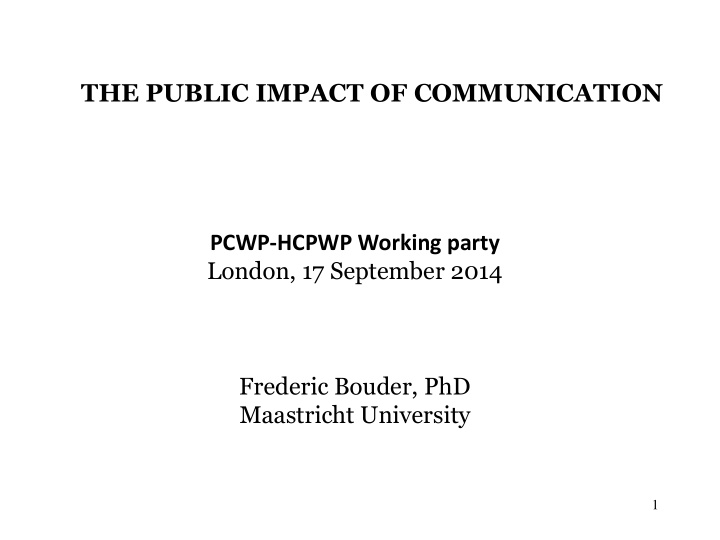



THE PUBLIC IMPACT OF COMMUNICATION PCWP-HCPWP Working party London, 17 September 2014 Frederic Bouder, PhD Maastricht University 1
Today’s session 1- What is benefit/ risk (and risk/risk) communication ? 2- Background example of Vioxx and its impact 2- Brief introduction to case 2
Why does Benefit/Risk Communication matter so much? Up to the early 1990’s – consensual style regulation in Europe. Decisions were made behind close doors. In the 1990’s – Series of regulatory failures: – BSE (UK and Europe) – Dioxin (Belgium) – Tainted Blood (France) Risk debate and Medicines: - MMR – UK - Vioxx/Cox2 inhibitors - Avandia… - Mediator – France 3
As a result the communication context is changing 1. Greater public and stakeholder participation 2. Greater consideration for environmental and social values 3. Greater transparency in regulatory strategies and decisions 4. More accountability of the regulator 5. Greater use of precaution 6. The role of Science is downplayed, as scientific results are increasingly under scrutiny - scientists seen as just another stakeholder 7. The role of Media is enhanced
EU policy trends in Pharma sector Maintaining dedicated web portals (e.g. safety-data on ADRs) Publishing documents (e.g. PSURs, RMPs and lists of monitored medicinal products) Introducing public hearings . Disclosure policy at new PRAC . Disclosing committee- meeting minutes (e.g. CHMP and PRAC) Public workshops (e.g. EMA’s November 2012 & 2013 consultations. Proposals to proact ively release data (e.g. EMA by 2014) October 20, 2014 Bouder, Way & Löfstedt 5
Are European regulators viewed as effective communicators? Bouder et al. 2014 NHS [or equivalent] The Government Figure: Bar chart showing respondents (%) Figure: Bar chart showing respondents (%) (N=5,648) answers to the question: “How (N=5,648) answers to the question: “How effective do you consider the NHS [or effective do you consider the government is at equivalent] is at providing members of the providing members of the general public with general public with information on medicines information on medicines such as a health such as a health alert about a flu outbreak?” alert about a flu outbreak?” Blue shading Blue shading signifies very effective. Red signifies very effective. Red shading signifies 10/20/2014 6 shading signifies fairly effective. fairly effective.
Who is trusted and who is not? Bouder et al. 2014 Figure: Bar Chart showing how trustworthy respondents (%) (N=5,648) felt a predetermined list of sources of information are in (a) providing them with advice about medicines or communicating health alerts (blue shading) and; (b) providing them with advice on the side effects associated with specific medicines (red shading). The bar chart represents the % of respondents that chose very or fairly trustworthy for each source of advice. 10/20/2014 7
What can we learn from advancements in decision sciences? ‘(…) Interactively sharing risk and benefit information with the public to enable people to make informed independent judgments’ ( FDA Risk Communication Advisory Committee )
Science of communication Psychometrics Starr 1969; Fischhoff et al. 1979, Slovic 1987 etc. Intuition and rationality Kahneman and Tversky 1974; Slovic 2001 Trust Renn and Levine 1991; Lofstedt 2005
Risk perception drivers Natural – Technological Voluntary – Involuntary Familiar – Non Familiar Control – Non Control High Frequency/Low Consequence Risk VS Low Frequency/High Consequence Risk Child – no child Reproduction Classified - 10
Trust- No Trust
Fairness, competence, efficiency (Renn and Levine 1992) “Well I would rather have a med approved then not, but they are definitely in cahoots with the drug companies.” “They try to do a good job but I don’t think they have enough resources to take care of all of it.”
Risk perception and pharma Product Low Moderate High Dread Perception Vitamin pills X Acupuncture X Aspirin X Valium X Antibiotics X Cancer chemotherapy X Diet medicines X Depression and X anxiety medicines AIDS therapies X DNA technology X
Media and perception Risk amplification/attenuation (Kasperson & Kasperson 1988; Pidgeon et al. 2003 Information passes from sender to receiver Intermediate stations of a communication chain (individuals; medias; NGOs etc.) change the message Ripple effects, may amplify (or attenuate)perceptions
Example: Cox2 Inhibitors Pain relief sometime presented as ‘super aspirin’ Non-steroidal anti-inflamatory drug (NSDAID), reducing the risk of ulceration /stomach bleeding Withdrawal (11/04) after concerns for increased ‘vascular events’ Amplification: intense media coverage and US senate hearing (11/04), UK House of Commons (04/05)…
What was the problem with Vioxx 2004 withdrawal (Löfstedt 2007) Manufacturer seen as presenting a biased picture (Bowe 2005) publishing only results that suits them + aggressive DTC “Whistle blower’’ factor within FDA: Should the product have been been taken earlier? Regulator‘s ambiguity : ‘’ Vioxx was no less risky than having poor diet’’. Then why being so precautionary?
Lessons from Vioxx/Cox2 inhibitors The Cox-2 inhibitor crisis has thrust pharmaceutical regulation into the post-trust era of risk communication: pharma industry less credible actor, and regulators questioned. Improving public impact? - Science-based : being clearer about benefit/risks but also risk /risk - Proactive and well articulated message - Test for trust - Associating oneself with more-trusted actors
Effective communication of benefit and risks
Key variables (Löfstedt 2005; Bouder and Löfstedt 2008; Bouder 2010) State of scientific knowledge Balancing of the message Frequents dialogues ? Confrontation ? Lawyers? What neutral third parties say NGOs/patients
Practical case: Diclofenac Diclofenac – NSAID, authorised for relief of pain and inflammation Reason for review: Previous reviews (2005, 2006 and 2012) have suggested an increased relative risk of arterial thromboembolic events, sometimes greater than commonly prescribed NSAIDs and certain COX-2-inhibitors. Risk issue: There is a small risk of heart attack or stroke in patients taking systemic diclofenac regularly, especially at high doses and for long periods.
Recommend
More recommend